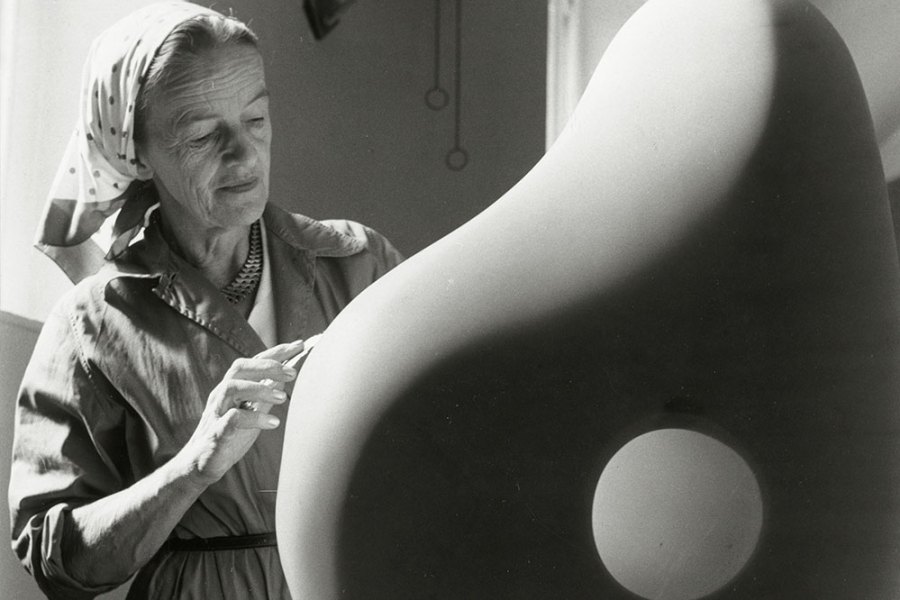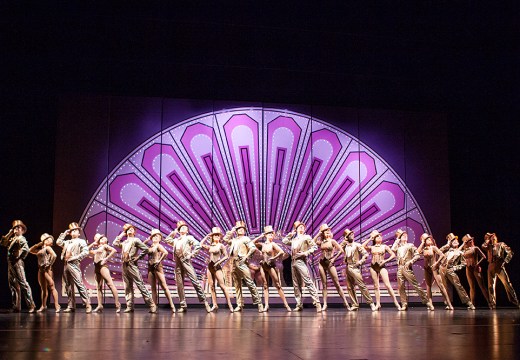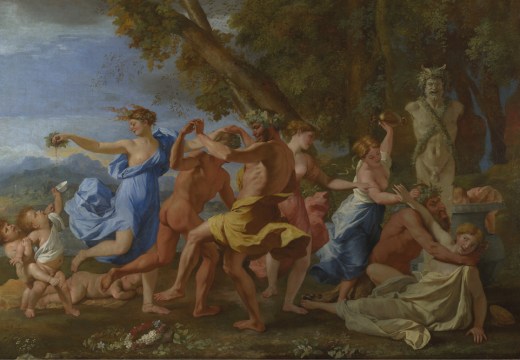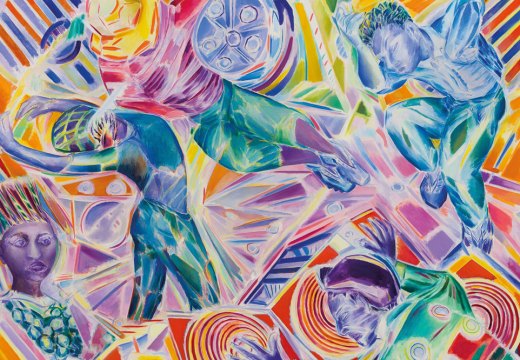From the March 2023 issue of Apollo. Preview and subscribe here.
Sixty years after its last Saturday night hop, the hall of the St Ives Palais still yearns to be danced in. ‘The finest sprung floor in the south-west, it claimed to be,’ Sophie Bowness says. It’s easy to imagine the space filled at night with jiving ghosts – or tangoing, in the case of Bowness’s grandmother, who, as she gleefully wrote in a letter to a friend, learned two new dances there on a single evening in 1951. The grandmother’s name was Barbara Hepworth.
Dance played a large part in Hepworth’s life. A far-sighted headmistress at Wakefield Girls’ High School, Miss McCroben, had encouraged dance as an essential part of learning, introducing her charges to Dalcroze eurhythmics, intended to tune the body for musical perception. Drawings such as The Shadow Dance (1919) suggest the effect on the teenage Hepworth. Much later, she would say that in sculpture, ‘one is physically involved […] It’s rhythm and dance and everything.’
The two strands in her life came together when, in 1961, the Palais de Danse in St Ives came up for sale. For 12 years, Hepworth had lived diagonally opposite, in Trewyn, the house she took on as a studio in 1949. She would stay there until her death in 1975: it is now the Barbara Hepworth Museum and Sculpture Garden. She had bought Trewyn at an auction held in the Palais de Danse. Now she bought the Palais itself.
Proximity to the dance hall had been a mixed blessing: its band could not be relied on to play in tune, which set the musically gifted Hepworth’s teeth on edge. Sophie Bowness’s mother, Sarah, one of Hepworth’s triplets with Ben Nicholson, remembered merry dancers ‘thundering down the hill past the house late at night’. (One of these may have been Francis Bacon’s boyfriend, Ronnie Belton – Hepworth was not the only member of the St Ives art world to like a turn on the floor.)

Hepworth with the plaster for Single Form (Memorial) (BH 314) in the Palais de Danse, March 1962. Photo: Studio St Ives, Barbara Hepworth; © Bowness
The first thing that must have struck Hepworth about her new acquisition was the sheer space. A makeover in 1951 had left it with a six-metre, Deco-ish barrel vault and, at the back, under the gallery – the Palais had doubled as St Ives’s first cinema – was a floor-to-ceiling mirror. Writing to friends in 1949, she had complained of the lack of room at her old studio at Chy-an-Kerris on Carbis Bay: ‘If I ever get any money & can get myself a barn to convert into a workshop & living quarters I shall,’ she wrote. Trewyn, with its walled gardens and outbuildings, had allowed her to work on a larger scale.
By 1961, though, she was internationally famous, with commissions for monumental works in public spaces – parks, plazas, the facades of department stores – coming in from all over the world. Trewyn, as a studio, had grown too small for her. She would work on these new commissions in the Palais de Danse. A photograph from March 1961 shows her on the dance floor, her sculptures stood on plinths with rubberised wheels so that Hepworth could move them around, seeing them in relation to each other and in space. She danced them, danced with them. The effect on her work was instantaneous and clear. When the show ‘Barbara Hepworth: An Exhibition of Sculpture from 1952–1962’ opened at the Whitechapel Gallery, just over a year after her move to the Palais, its curator, Bryan Robertson, noted: ‘The [latest works] are dynamic, and […] with a compressed energy which is quite new.’ The new works were not simply bigger. They were, counterintuitively, less earthbound, lighter on their feet.
Included in the Whitechapel show was the plaster version of a piece called Single Form. Among the many fans Hepworth had gained in the previous decade was the United Nations Secretary-General, Dag Hammarskjöld. Hammarskjöld owned a number of her works, including an earlier version of Single Form in sandalwood; discussing her art, he and Hepworth had become friends. In September 1961, the charismatic Swede, on a peace-keeping mission in Africa, was killed in a plane crash. Hepworth was left in ‘a kind of despair’.
In the ground-floor space beneath the Palais’ dance floor, she set to work on a memorial to Hammarskjöld, a 6.5m-high bronze she would call Single Form (Memorial). Since 1964, the work has stood outside the United Nations Secretariat Building in New York, Hepworth’s largest sculpture and her most famous. In the circle that pierces the work’s upper part like an eye or a wound, in her own hand she has inscribed, ‘To the glory of God, and the memory of Dag Hammarskjöld.’
Anne Barlow, director of Tate St Ives, ponders the floor in the space under the dance hall. On its concrete surface is scratched a rough grid, still visible 60 years after it was made. It was here that Barbara Hepworth worked on Single Form (Memorial) throughout the bitter winter of 1962–63. ‘It is,’ she wrote to a friend at the time, ‘the most arduous & exacting work of my life’. So large was the bronze that it had to be cast in seven pieces, each requiring its own model, gridded up and carved by Hepworth in wood and coated in plaster. To the surface of these she added a variety of textures using ‘axes, rakes, hatchets’. It is hard not to see, in the scarified bronze of the final Single Form (Memorial), echoes of the ferocity of its making.
The Scottish-born Barlow was in America for 20 years before getting the Tate job in 2017. For her, seeing the place where Single Form was carved is ‘magical’: ‘Coming from New York, having so often seen the piece outside the UN, and now being able to see that gridded pattern where she’d worked on it – it was just fantastic. You get an idea of Hepworth’s process at the Palais de Danse in a way that you don’t at Trewyn.’
The gift of the dance hall by the Hepworth family to Tate St Ives in 2015 is both an opportunity and a conundrum. When Barbara Hepworth died in a fire at Trewyn in 1975, the Palais de Danse went into a decades-long slumber. It was used as an office and store by the Hepworth Estate, plasters and prototypes being kept in the dance hall itself. (These are now in the Hepworth Wakefield.) Occasionally, an artist occupied the Palais for a residency: the sculptor Veronica Ryan (who won the Turner Prize in 2022) worked there from 1998 to 2000, making artworks from Hepworth’s unused marble, also donated by the estate.
But while the Palais de Danse is still very much as Hepworth left it in May 1975, it is also remarkably as she had found it 14 years earlier. ‘It’s notable how much Barbara left it alone,’ Bowness notes. The building is a hodgepodge of eras and styles, in brick and stone and plaster and slate, dating from the 18th century to 1951 and beyond.

Hepworth on the dance-floor, Palais de Danse, March 1961. Photo: Studio St Ives, Barbara Hepworth; © Bowness
‘It has been the site of a navigation school for boys, a builders’ merchants, a billiards club, a dance school, a place for cookery demonstrations and Conservative meetings,’ Bowness says. There was a ‘wonderful, purple, spherical, tropical fish that lived in a tank in the hall, a gift from [the gallerist] Gilbert Lloyd for Barbara’s seventieth birthday… I believe it came to a sorry end, exploding, I’d imagine through over-feeding.’
The Palais de Danse is a neat extension to the story told across the road, at the Hepworth Museum. It extends that story chronologically, taking in the last years of the sculptor’s life, and aesthetically, including her larger-scale late works. But it is also a relic of St Ives itself. Older St Ivesians often have a Palais story – parents who met at a dance, films they saw there as children. During repair work shortly before the building was given to the Tate, a lipstick from the 1950s was found under the staircase. This is now preserved in the gallery’s storerooms, along with the wheeled plinths and the glassine doors that Hepworth would dramatically slide back to reveal her works, standing like dancers on the well-sprung floor.
The question facing Anne Barlow is how to square these two disparate but overlapping histories. She talks of other uses to which the Palais might be put, for live performance or artists’ residencies, as a local amenity. Tate St Ives recently announced a competition to ‘reinvigorate’ the building, the project to be completed by 2026. The grid on the floor where Hepworth carved the models for Memorial seems likely to be preserved, but what of the nondescript space at the back of the building where, in 1963, she worked on the famous Winged Figure on the side of the Oxford Street branch of John Lewis, seen by 200 million people a year? And what, above all, of the dance floor? Whichever project wins the Tate’s competition, the hope is that the building’s 50-year sleep will be over; that its story, and Hepworth’s, will dance around each other again.
From the March 2023 issue of Apollo. Preview and subscribe here.
Unlimited access from just $16 every 3 months
Subscribe to get unlimited and exclusive access to the top art stories, interviews and exhibition reviews.














![Masterpiece [Re]discovery 2022. Photo: Ben Fisher Photography, courtesy of Masterpiece London](http://www.apollo-magazine.com/wp-content/uploads/2022/07/MPL2022_4263.jpg)
It’s time for the government of London to return to its rightful home